Water. Essential for life, plenty of it at sea, but none of it is good for human consumption. For centuries, the common solutions included carrying fresh water onto ships, desalination by distillation and capturing rainwater. None of these methods were both reliable and convenient. However, today, thanks to technology, we have a solution that is both.
In this post we will: 1) give you a good understanding of how a watermaker runs. This is essential for you to understand how it can fail and how to go about diagnosing and solving problems; 2) share what we have learned with regards to maintenance, as well as 3) considerations to have on a catamaran specifically.
💧 What is this magical device that makes water?#
Many sailors before us crossed oceans without a watermaker, but with stringent water rationing and sometimes reliance on natural sources like rainwater 🌧️. Today, we have access to technology that allows us more comfort and a safety net for long offshore passages.
So why wouldn’t you want to have one? Or two! 😉
It’s important to recognize that a watermaker is a sophisticated piece of equipment requiring careful operation and regular maintenance. In addition, there seems to be much confusion about how they work and how to care for them. We were told different things by different people (including professionals), sometimes received erroneous or incorrect information, and it took us quite some reading and discussions with several representatives of watermaker brands to get a better understanding.
Here we try to dismistify and unwrap the intricacies of watermakers based on first principles, explore their inner workings, as well as outline proper usage and maintenance practices.
📝 Note: We have installed Dessalator and Rainman watermakers on Nuvem Mágica, so those are the two systems we will be talking about.
⚙️ How does a watermaker work?#
🧂 Desalination#
You make fresh water out of sea water through desalination, a process by which saline water is converted to fresh water. Several methods of desalination exist and can be divided in either thermal methods (e.g. distillation) or membrane-based methods (e.g. reverse osmosis). We’ll keep it simple here, but do feel free to step into this rabbit hole (which includes wave-powered desalination, a fascinating idea 🤩).
The leading process for desalination in terms of capacity is reverse osmosis (RO). RO uses semipermeable membranes and applied pressure to preferentially induce water permeation through the membrane while rejecting salts. This is the core principle used by watermakers aboard vessels.
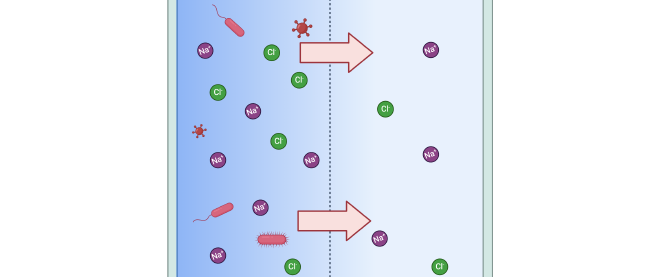
🚰 What is needed to make this work?#
A watermaker is composed of:
- A through-hull or hose, to let sea water in;
- A strainer, pre-filter or both, to remove macroscopic particles or marine life and then particles larger than 5 µm from the incoming water;
- A high-pressure pump, which increases the pressure inside the system and pumps the incoming sea water into the central components of a watermaker…
- The membranes. This is where the reverse osmosis magic 🪄 happens: a small percentage (~20%) of the water molecules is “pushed” through the semipermeable membranes and collected into the water tanks (product water), while the remaining (more concentrated) water (called brine) is thrown away.
- Salinity sensor: this sensor is placed after the membranes, and measures the concentration of salt in the product water. If it is too high, the product should be rejected. Some systems do this automatically.
- Pressure sensor: generating a pressure that is greater than the osmotic pressure is the core of reverse osmosis. However, if you put too much pressure in the system, you can damage your membranes. Thus, a pressure sensor is installed, in order to monitor this variable.
- A flushing/rinsing system, to rinse/clean the membranes.
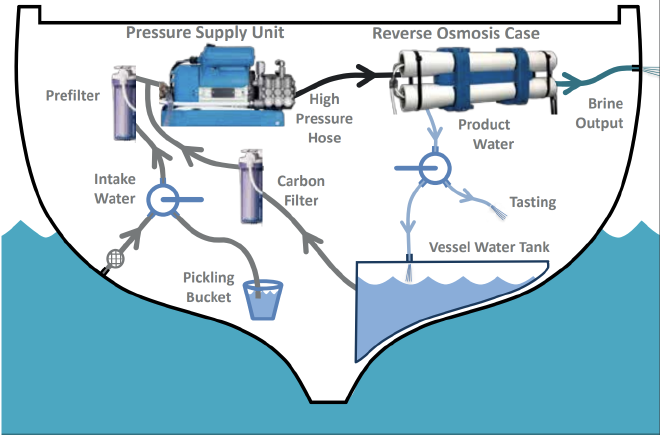
🦠 A word on water safety#
There is often some confusion about whether water produced by watermakers removes microorganisms. To whole point of a watermaker is to remove salt ions from seawater. Thus reverse osmosis membranes have a very small pore size, of approximately 0.0001 µm (0.1 nm). This means that reverse osmosis systems have a very high effectiveness in removing parasites, bacteria, viruses, and even some (but not all) chemical contaminants (metal ions, aqueous salts).
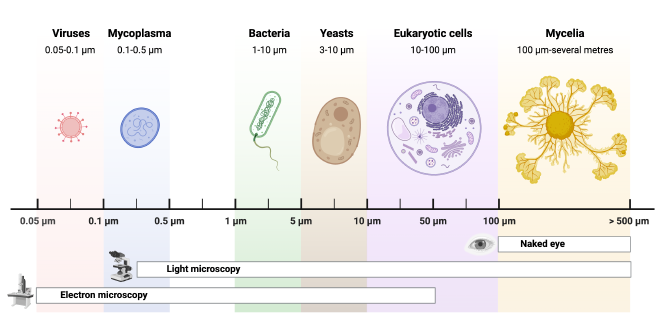
This is great news when it comes to water safety, but it highlights that it is still important to (1) carefully choose where you make water and (2) maintain your watermaker properly, so that your membranes remane intact.
🐳 Proper usage#
First and foremost, start by reading your equipment’s manual(s). This post tries to give you some general pointers (the big picture), but every manufacturer has its specific usage requirements and maintenance schedules.
☠️ Membrane killers#
Let’s start by what not to do.
Reverse osmosis membranes are the most sensitive parts of the watermaker system. Several things can damage them:
- Chlorine: never allow water containing chlorine to enter your watermaker. That includes town or tap water, which contains chlorine, or water from a vessel’s tanks, which also may contain chlorine.
- Diesel/murky waters: never make water in a marina or polluted areas.
- Air: air in the system damages membranes, but it’s a controversial subject for catamarans. More on that in a following section.
- Pressure: surprising? Pressure is what makes reverse osmosis work, but if you crank it up, you will also damage (fracture) the membranes.
🏝️ Ok… where can I make water, then?#
The ideal place to make water is in pristine anchorages, which means:
- There are no or just a few other boats around (reduces the likelihood of finding traces of diesel… or other unpleasant things 💩).
- The water is clear.
If there is a current that brings water from outside and flushes the bay, even better.
However, as bluewater cruisers and offshore sailors, we want a watermaker to make water underway, as we are sailing. Why is sailing not an optimal condition for making water? There is trouble in the bubbles 🫧!
🌬️ Are catamarans particularly vulnerable?#
As mentioned before, air in the system will damage the membranes. As was explained to us by a Dessalator representative that works closely with Outremer, catamarans are especially vulnerable to this due to:
- their lower draught (meaning the water intake through-hull is closer to the water surface);
- the fact that they tend to sail faster (performance catamarans more so);
In the end, it seems increased speed and waves lead to more cavitation and can bring air bubbles through the through-hull, and into the watermaker system.
We learned this the hard way: we had to replace all our membranes, which were barely 1.5 years old!
Making water underway continues to be a debate, with many folks claiming it isn’t an issue. We are the “better-safe-than-sorry” kind of people and so, to minimize the chances of air getting into the system, we strive to follow the recommendations we received from Dessalator. We were told to make water underway (ideally only) if:
- Conditions are calm (no big swells);
- Sailing at 6 knots or less.
🎩 Bonus tips#
💨 Dealing with air in the system#
Since we were told that air is a problem on catamarans, we have taken upon ourselves to monitor the situation closely:
- Before we start our Dessalator watermaker, we bleed the system using the screw at the top of the pre-filter (see image below).
- Finally, we inspect the pre-filter (from the side, as on the photograph) for air before, during and after usage.
No one told us to do this. We just use it as a way to monitor whether air is coming into the system or not, and relate that to the conditions in which we last made water.
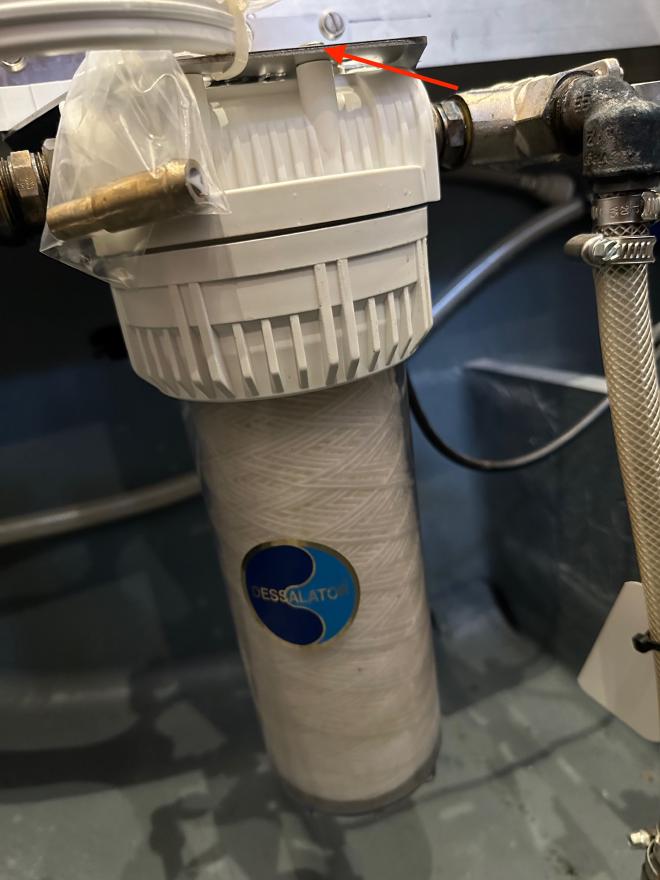
In addition, we installed a small hose within the Dessalator pre-filter to bypass air potentially lodged in the filter. This DYI solution was recommended to us by Dessalator.
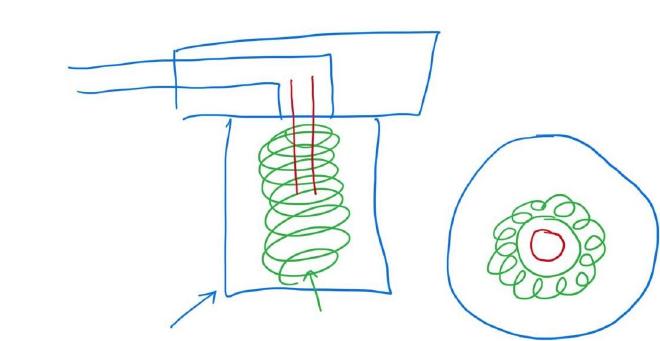
The Rainman system does not have a way to bleed the pre-filter, but we got the following recommendation from their (very responsive ❤️) support team: If air is getting into your intake, you will see air in the prefilter, pressure fluctuations at the pump, vibrating hoses, and have a white looking raw water discharge. These, for us, would be signs to stop the system.
Interestingly enough though, we have heard from a charter company (that almost exclusively uses Rainman watermakers) that they rarely have issues with this brand’s devices. Note that charter boats are not known for being handled with the utmost care by guests! This means that if Rainman watermakers survive well in those conditions, then ours should do just fine for us.
One final thing you can consider is the position of the through-hull versus the tack you are currently on:
- Does the current tack place the through-hull closer to the water surface, compared to the opposite tack?
- Or is the through-hull at the lowest point of the hull and the tack does not play a role?
In the end, we have only recently installed our Rainman watermaker… but begin to wonder: is air really what has been behind our issues with the Dessalator membranes? Or, as has been suggested to us several times, is the quality of the membranes simply inferior?
🏊♀️ Dealing with chlorine when you have two tanks#
Here is a great trick that was suggested to us by Pascal Petit, from GLS Antilles. On Nuvem Mágica, we now only fill the port tank with water from marinas. The starboard tank (which is where water for membrane rinsing is taken) is exclusively reserved for watermaker water. Thus, when we are in a marina, we:
- Turn off the fresh water pump on starboard (leave the one on port side on);
- Open our hull connection so that the water from port side can circulate to starboard.
And voilà! Now only the fresh water from the port tank will be used, and your chlorine-free tank will remain chlorine free.
🧑🔧 Watermaker maintenance#
🩺 How to test the health of your membranes#
The way you evaluate the health of your membranes is by testing the quality of the water they produce. You can test water quality at multiple levels:
- At the outset of a membrane: this allows you to test the water quality from a specific membrane;
- Using the hose connected to the water tank: here you get pooled water from all the membranes in your watermaker;
- By opening the tap: here, you pull water from your tank, which may be a mixture of watermaker water, marina water, rainwater etc., depending on how you use it.
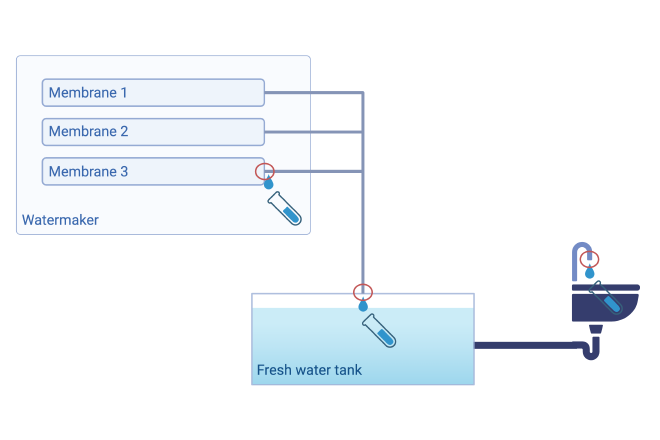
Of course, the more you move away from your unit membrane, the less precise your diagnosis will be. It might be that one membrane is completely kaput, but since the other 2 still perform a decent job, you still pull drinkable water from your tank.
However you decide to sample your water, you should conduct total dissolved solids (TDS) readings regularly (TDS meters can be easily found in marine shops). The readings will vary throughout the life of your system, and should increase slowly over several years. Drinking water should ideally contain <500 ppm (parts per million), but most people change the membranes once they get to about 700-800 ppm of TDS.
🚿 A word on membrane rinsing & pickling#
Again, it is worth reading your system’s manual to know when to do what. However, we can also say that not all manuals contain clear indications.
As a reference, here is the recommended procedure for the Rainman watermaker systems and from Dessalator:
| Unused Period | Rainman Treatment | Dessalator Treatment |
|---|---|---|
| 2 days or less | No treatment necessary. | Unclear in user manual: It is necessary to rinse the watermaker if it is not going to be used for several days. |
| Between 2 and 7 days | Fresh water flush. | Unclear in user manual: It is necessary to rinse the watermaker if it is not going to be used for several days. |
| Between 7 and 30 days | Pickle the system. | Unclear in user manual: Under normal circumstances, a monthly and regular rinsing of the membranes is enough for their maintenance. |
| 30 days or more | Pickle the system, discard the pre-filter and drain the pre-filter housing. Some pre-filters can turn black if stored too long in pickling solution. | Pickle the system (max. 2 times per year). |
To avoid having to rinse or pickle/sterilize, many boat owners opt to use their watermakers regularly. A bit every day 😉
🧴 Regular Machinery Maintenance#
| Item | Rainman Treatment | Dessalator Treatment |
|---|---|---|
| Pre-filter | Regular replacement, once it is visibly fouled. | No documentation. |
| Impeller | Might wear and tear, and need replacement. | No documentation. |
| High pressure pump | Might need an oil change | No documentation. |
⚖️ Our experience owning Dessalator vs. Rainman#
We’ve been two times without watermaker (both times due to our Dessalator failing). Given drought laws in certain countries that forbid providing fresh water for boats without a berth in the marina, we’ve been caught multiple times struggling to get fresh water onboard. We swore to solve this problem by adding redundancy, and that is how we got to Rainman.
| Rainman | Dessalator | |
|---|---|---|
| Output | 140 liters/hour | 100 liters/hour |
| Flushing | With AutoFlush module, flushes automatically after use and once every 7 days | Needs to be manual flushed after use |
| Pressure | Manual pressure adjustment | Automatic pressure adjustment (very handy) |
We are really happy to have both watermakers. We can now generate up to 240L/hour and hope to not be caught off guard if one fails… as we now have another one. Perfect for our expeditions ⛵️
We hope this post is useful to you. If you have any questions or feedback, get in touch 💬!
Until next time,
Your Nuvem Mágica
📚 Resources#
- Desalination, Wikipedia
- Reverse osmosis, Wkipedia
- Watermaker, Wikipedia
- Water Disinfection, CDC Yellow Book 2024
- Water treatment while hiking, camping, and traveling, CDC
- Making Water Safe in an Emergency, CDC
- A Guide to Drinking Water Treatment Technologies for Household Use, CDC
- How to install a DIY watermaker (SeaWater Pro) // Ryan’s Tech Corner #5
- Rainman Watermaker manuals
- Dessalator watermaker manuals
